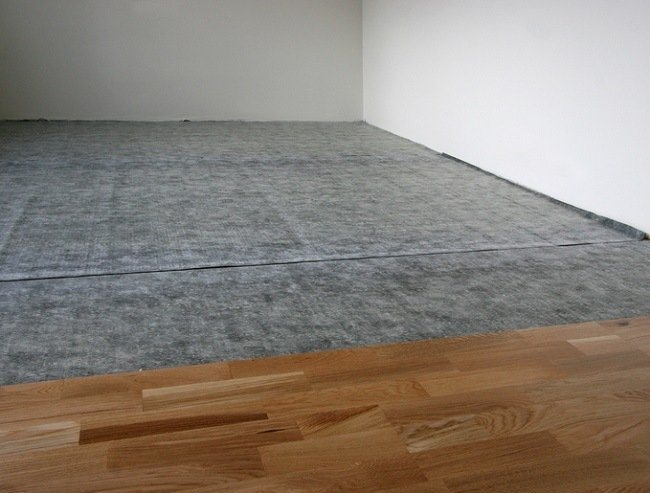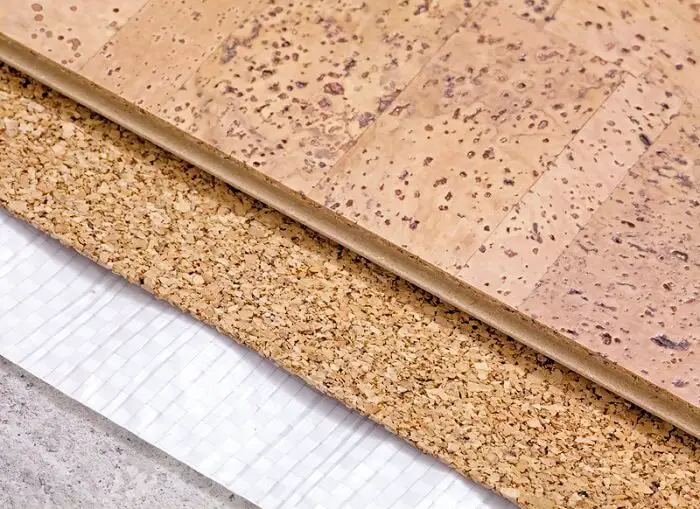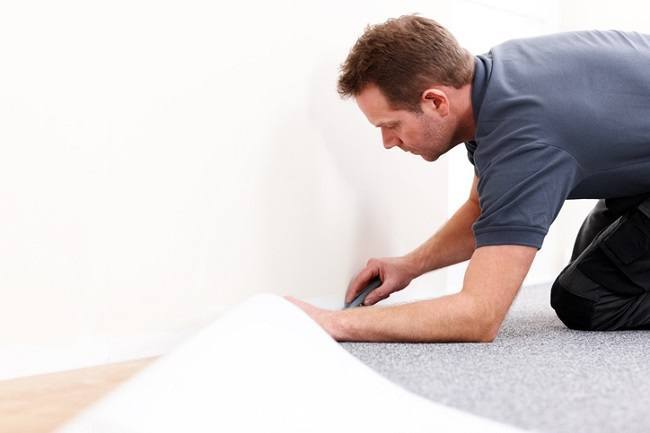Carpet underlay is an essential accessory to carpets. It is vital for protecting your carpet against wear and tear and thereby enhancing the life of the carpet.
Underlay can be used to help improve sound absorption efficiency, helping to reduce noise levels in your home and stop your downstairs neighbours from hearing your every footstep.
The most effective carpet underlays for soundproofing are made from rubber & cork.

Any underlay you want to use for soundproofing a floor should have a Noise Reduction Coefficient (NRC) rating of at least 0.4. In simple terms, underlay with an NRC rating of 0.4 should absorb 40% of footfall noise.
Below we have put together a list of different acoustic underlays ranked from most to least effective for soundproofing:
Best Types Of Soundproof Underlay:
1. Rubber Cork Underlay
A rubber cork underlay is made from a mix of rubbers & cork. This gives it a high density which allow it to offer exceptional acoustic insulation.
Rubber-cork underlay is easy to install, lightweight, and moisture resistant along with being an environmentally friendly product.
- Designed to be used under ceramic tiles and natural floors, but can be used under hardwoods, luxury
- Has been specifically formulated to prevent crack formation on the flooring surface due to subfloor
- Can be installed under the whole flooring surface or just in areas where cracks have occurred
It provides superior heat (and sound) insulation and is a cost-effective solution to save money spent on heat energy. Rubber cork underlay should not be used in high moisture areas such as kitchens or bathrooms.
Pros
- Good protection from cracking
- Easy installation
- High density makes them good at blocking sound
Cons
- Not suitable for bathrooms or kitchens as they don’t react well to moisture.
2. Rubber Underlay
Rubber is one of the best sound absorbing underlay materials that experts recommend. Most rubber underlay is produced from recycled rubber making it far more environmentally friendly than it used to be.
Commercially available rubber underlay is easy to install and doesn’t need to be glued with adhesives. In fact, these products are super strong and resilient to wear and tear.
They provide soft, comfortable underfoot padding, and are usually available in flat or waffle designs. Flat underlay offers greater support and stability to the carpet, while waffle underlay provides a more comfortable feel underfoot as well as maginally improving the thermal insulation of the underlay.
Pros
- Effective acoustic insulation.
- Easy installation.
- Versatile and multi-purpose.
- Firm underfoot support.
- Suitable for rooms with higher noise levels
Cons
- Can stain your carpet.
- Costlier than other underlayers.
- Difficult to trim and cut.
3. Cork Underlay
Cork underlay isone of the strongest sound absorbing materials. Cork is known to be a fantastic acoustic insulator which is also very effective for heat insulation too.

Cork underlay is usually made from the outer bark of the cork oak tree. Cork is also excellent at eliminating bacteria, mildew, and mold growth. It is easy to maintain and has a long life duration.
No products found.
Pros
- Good levels of sound insulation.
- Protection from mold and mildew.
- Can be easily trimmed for installation in cramped spaces.
Cons
- Requires a moisture barrier.
Suitable for
- Rooms away from moisture (not kitchens of bathrooms)
- Library or TV rooms
4. Crumb Rubber Underlay
Crumb rubber underlay is manufactured using old or recycled car tires, making it an environmentally-friendly underlay solution.
No products found.
It is highly durable and resilient and known to provide extra firmness to the carpet.
Pros
- High density for better carpet support.
- Eco-friendly—made from recycled materials.
- Superior acoustic absorption for better soundproofing.
- Resilient material – not affected by heavy furniture.
- Hallways, stairways, living rooms, dining rooms, and other areas with heavy furniture.
Cons
- Not as comfortable as other underlay.
5. Felt Underlay
Felt underlay has high-density as it is produced from recycled fibers. It can be mixed with wool, jute, fabric bags, and even old clothes making it a solidly eco-friendly option. It owes its sound absorbtion capacity to its high density.
No products found.
Felt underlay is strong and less susceptible to crumble under the pressure of heavy furniture. It is made of wool fibers which are also great for heat insulation as well.
Pros
- Strong & durable.
- Environmentally friendly option.
- Cost-effective solution.
- Comfortable underfoot.
- Cheaper than rubber or foam underlay.
- Works well in most areas.
- Best suited for woven carpets.
Cons
- Not very comfortable cushioning.
6. Foam Underlay
Foam is the most inexpensive form of carpet underlay.
It is made from either prime Polyurethane material or bonded polyurethane chip material. Foam underlay can be used under soft carpets but is not suitable for wood and vinyl floors.
- ✔ Use with Laminate and Floating Wood Floors. Approved for floors with a pre-attached pad.
- ✔ Superior Sound Reduction ‐ Recycled fibers absorb sound and keep it from traveling to other rooms. Makes click-together floating floors sound solid underfoot.
- ✔ Compression Resistant ‐ Dense intertwined structure supports the seams of your floor and won't compress under consistent foot traffic.
Most foam underlay offer moisture protection and resistance against mold and mildew. It usually will come with an adhesive glue strip and is quite easy to install.
Pros
- Soft cushioning for added comfort.
- Eco-friendly material that can be easily recycled.
- Efficient thermal insulation.
- Good sound insulation.
- Designed for bedrooms and living rooms for added comfort and luxurious under-feet padding.
Cons
- Prone to indents from heavy furniture.
- May compress over a longer duration.
Carpet underlay is a cost-effective solution for improving carpet life as well as improving thermal and sound insulation in your room.
What Is Carpet Underlay?
A carpet underlay is a thin layer of cushioning installed beneath the carpet. They are created out of different materials including felt, rubber, cork, sponge, foam, rubber cork, and crumb rubber.

Underlay is an essential accessory to carpets. And there are different variants available in the market depending on their thickness, density, and material.
Also Read: Does Carpeting Your Walls Help Soundproof Them?
Additional Benefits of Carpet Underlay
Soundproof underlay is valuable not just because it can help muffle sound, here are some other reasons why you should invest in some good quality underlay:
- Increases longevity
It increases the longevity of the carpet. Underlay protects your carpet from indentation damage caused by heavy furniture and increases its lifespan.
- Enhances Comfort
A quality acoustic underlay adds a cushioning thickness of approximately 6 to 10 mm. This kind of extra padding improves the comfort and feel of the carpet.
- Reduces Wear and Tear
Underlay protects your carpet from friction and reduces the pressure of the hard flooring beneath it. This helps reduce wear and tear on the delicate strands of carpet threads, especially those that are handcrafted using silk or wool.
- Better Thermal Insulation
Underlay provides better thermal insulation than carpet alone. It comes with tiny holes that trap warmth inside and keep your home warm during winter. This prevents the cold from escaping through the extra layer, helping maintain ambient temperature levels throughout the year.
- Improved Sound Insulation
As already mentioned underlaycan help improve the sound resistance of your floor especially if you choose an underlay made from materials that have high sound absorbing qualities such as cork or rubber.
- Superior Moisture Resistance
The extra underlay padding protects your carpet as well as home from any moisture that may seep in through the flooring, minimising structural damage to your floor.
- Prevents Allergies
Most underlays are treated with anti-microbial treatments. Yhese products also help in preventing the growth of fungus, mildew, and mold. Using carpet underways is especially helpful in preventing allergens from spreading in your home.
What is soundproofing?
In a layman’s language, soundproofing is preventing the entrance of or reducing unwanted noise in your home.
The process of soundproofing uses different techniques that may diffuse, reflect, or absorb the sound waves and thus prevent them from entering your home.
There are lots of techniques that you can employ to help soundproof your home, some of the quickest, easiest and most budget friendly soundproofing wins come from things like soundproofing your doors and windows, or simply putting a rug down!
Types of noise
There are two different categories of noise—airborne noise and impact noise.
While airborne noise includes sounds of music, television, babies, animals, and means of transport, impact noise includes the noise made by walking, jumping, running, and dropping of objects.
What to consider when blocking noise?
Carpet underlays are perfect for blocking impact noise. Here are some factors to consider for using these underlays for blocking noise:
- Material:
High-density material like a sponge, rubber, foam is better for blocking impact noise.
- Thickness:
A thickness of about 8mm and above provides optimum protection from outside noise.
- Ease of application:
Underlay materials that come with adhesive glue strips are better suited for blocking noise as they will not move easily and will be more efficient at blocking noise.
As an Amazon Associate I may earn a small fee from qualifying purchases at no extra cost to you. This helps us run the site, so thanks for your support!


